To read the story, please click here
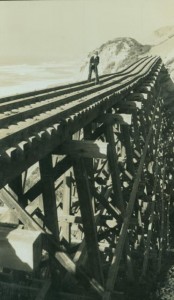

Created by June Morrall
To read the story, please click here

Story by John Vonderlin
Email John ([email protected])

Hi June,
A while back we were posting about the “New York,” the ship that ran aground in 1898, under very strange circumstances, almost in your front yard. The ship had been named the “‘T. F. Oakes,” and was renamed the “New York,” hoping for better luck, after a series of unfortunate events. They should have known better, based on my research into the fate of ships named “New York” through the years.
The following story, while occurring a bit beyond the subjective boundary of the Coastside, describes in detail the public’s reaction to a local shipwreck. In this case the ship is the “City of New York” and its story comes from the October 30th 1893, issue of the San Francisco “Morning Call.” It ran aground at the mouth of the Golden Gate off of Point Bonita on the Marin Headlands.
The article paints a scene of the curious, mixed with the profit or gaity-seeking, as if a circus had come to town. My guess is memories of this day were the stimulus for many a weekend picnic gawking adventure five years later, to view the forlorn hulk of the “New York,” that had run aground on your beach. My guess the scene at Half Moon Bay was similar, only longer lasting.
I’ll attach some info on the other ill-fated ships named “New York,” at the end of the article. I’m sure this streak of horrible luck for all these ships is just a strange coincidence, but I’ve got to wonder if the answer to the question of “What’s in a Name?” might be in some cases, “Destiny.” Enjoy. John
THE MORNING CALL, SAN FRANCISCO. MONDAY, OCTOBER 30, 1893.
PUMPING HER OUT.
The Efforts to Save the
Wrecked Steamer.
THOUSANDS VIEW THE SHIP.
The Bay Filled With All Manner of
Craft Bound for Point Bonita.
At The Cliff.
The wrecked steamship City of New
York lies in about the same position she
has been in for several days, and the pros
pects of saving her are all based upon the
success the pumps will have in reducing
the amount of water in her hold when they
get to wnrk and the continuance of the
present fair weather. It is admitted on
all sides that if a storm of even moderate
force should come up at this juncture all
hopes for the vessel would be lost.
The Day was alive with all kinds of
craft yesterday bound for the scene of the
wreck— steamers, tugs, naphtha launches,
Whitehall boats, skiffs, and, in fact, every
conceivable manner of conveyance by
water to be procured was brought into
requisition to convey the large crowds of
people who were anxious to view the dis
abled ship. One or two of the boats had
bands of music aboard to attract customers,
and all of them had from two to a half
dozen runners, who labored incessantly
and with loud voices to secure passengers.
In the afternoon the crowds on some of
the boats were immense, appearing at a
distance like one black, surging mass.
Little time was given the passengers for
observation, however, when the wreck
was reached, the efforts of the boat
owners being directed more particularly
toward making as many trips, and. conse
quently, as many dollars as possible with
out regard to the advantages given their
patrons.
On board the City of New York there
appeared to be but little activity, although
it was said that the pumps had about been
placed in position for work, and it was
thought probable that they would be put
in motion to-night at low tide. Donkey
engines have been placed on board to sup
ply the necessary power.
Alongside the wrecked ship lay a schooner
receiving what freight and other material
could be transferred to her. As the New
York lay yesterday afternoon her stern
was somewhat lower in the water than ber
bow. the gilt letters forming her name on
the former being just visible above the
small waves which washed about her.
Sume diversity of opinion exists as to the
exact extent of the damage done to the
hull of the vessel. It was said on board
the tug on which a reporter took passage
that one of the divers employed had stated
that he believed from the position of the
ship there was little if any hope of getting
her off safely. He said that a large rock
protruded through the hull and that the
action of the water in rocking the vessel to
and fro was gradually increasing the size
of the aperture and more firmly fixing the
ship in its critical position.
A big bank of clouds coming up on the
western horizon was viewed with a good
deal of anxiety by some of the officials
directing the work of relief aboard the
vessel last evening.
“If a storm comes up now,” said one of
them, “we might as well pull for the shore
and leave the vessel to her late. Ido not
believe she has settled in the water ma
terially during the past twenty-four hours,
and if we ran get the pumps to work and
they prove effective in reduciug the volume
of water in the, hold, I think the chances
iof getting her off are pretty fair. My chief
anxiety now, however, is about the
weather, and upon it depends the failure
or success of all future operations.”
Each one of the boats going and coming
from the wreck had the kodak fiends
aboard in various numbers. About a half
dozen of them took passage on the tug
Monarch at the time the reporter did, and
took snap shots at tho vessel from various
points of view.
THE CLIFF-HOUSE VIEW.
Nearly Forty Thousand Spectators
on Sutro Heights.
Not since the explosion of several tons
of dynamite by the wreck of the schooner
Parallel near the Seal Rocks some years
ago has there been such a multitude at
and about the Cliff House as gathered in
that vicinity yesterday. It is estimated
that between 30,000 and 40,000 people were
carried from the city on the two railroads
to the ocean shore. The rush was con
tinuous from early in the morning until
the sun went down.
The managers found it difficult to handle
the traffic. The ringing of the conductor’s
bell-punch knew no cessation,and yet
hundreds of passengers escaped
paying toll because the collector of fares
could not reach them.
The Cliff House and Ferries Road car
ried the greater number of people. The
pressure upon that route was something
phenomenal, though the Park and Ocean
road had also all it could do to accom
modate its patrons. Extra trains were
run at short intervals on both lines.
The weather during the afternoon was
superb. The ocean was apparently with
out a ripple. There was hardly enough
wind to stir a rose leaf. The view of the
opposite headland was perfect. The
white building upon which is built the
Point Bonita light stood out with striking
prominence against the gray rolling hills
behind it. Tugboats and other craft were
distinctly made out skimming over the
mirror-like surface of the water near the
Marin County shore.
What all had come to see, however, was
the wrecked steamer. But the City of
New York, with its partly submerged hull,
was lying in the deep shadows cast by the
rocks that towered above and about it.
Without the aid of a good field-glass the
ill-fated steamer could not be seen to any
advantage. Those endowed with the
keenest vision were able to catch a glimpse
of its outlines and masts and to indi
cate the locality to those less acute of
vision.
From Lands End station to the Cliff
House beach the shore and adjacent hills
were dotted with men, women and chil
dren silently gazing at the opposite shore.
Here and there a hilltop fairly swarmed
with people. The Cliff House veranda
itself was thronged all day and the roads
leading to it filled with vehicles. If the
people saw but little of the wreck they
seemed to bo enjoying their outing, for the
day was one of rare loveliness, and the
view of the ocean and the entrance to the
harbor was full of bewitching enchant
ment.
The grounds at Sutro Heights have
seldom or never had such a concourse of
visitors. Out on the semicircular parapet
the crowd was enormous. A young man
with a telescope mounted on a tripod
coined money at 10 cents a peep. A line
was formed by those awaiting their turu
to see the wreck through his lens. A
dozen telescopes would have proved in
adequate to the public demand for that
aid to vision. The enterprising youth
made enough money in a few hours to
carry him through a hard winter. His
pockets were so weighted down with
silver that he was obliged to secure as
sistance to aid him in packing his instru
ments off the ground.
J. Hampton Hoge, the newly appointed
American Consul to Amoy, was anxious
to see through the glass the steamer upon
which he had intended sailing to China,
but his gallantry baffled his desire.
Whenever it came his turn to take a peep
he discovered the next person behind him
to be a lady. Mr. Hoge is a Virginia
gentleman, and in every instance he
stepped aside to allow the ladies to use the
telescope first. His gallantry was not
appreciated by the other men in the line,
and Mr. Hoge had to go to the rear of the
line every time he yielded his right. The
result was that when darkness fell the
gallant Virginian was somewhere near the
tail end and never saw the City of New
York through tiie big glass.
FROM THE POINT.
The Steamer Viewed From the Bluff
Above the Wreck.
Point Bouita presented a livelier ap
pearance yesterday thau it probably ever
did before. It was the objective point of
tbe largest number of sightseers that ewr
visited the place, it beiug estimated that In
the neighborhood of 500 people crossed the
hills during the day to view the wrecked
steamer City of New York, and ‘JO percent
of the visitors tramped across the hills,
carrying their lunches with them and mak
ing the occasion an excuse for taking the
walk and enjoying a day’s outing. Early
in the day the prospects were in favor of
foegy weather, but Dy the time the advance
nuard of the big procession reached the
point the fog lifted and everybody had a
good view of the stranded vessel. The
common remark was that the steamer
showed little signs of being unable to
leave her position, but looked more as If
lying at anchor waiting for orders. The
wrecking tugs laid alongside all day tak
ing off articles of value, but to the ob
server on shore it appeared that no great
enon was being made to dismantle tbe
steamer. While some of the men aboard
s.’ni) were engaged in labor it was notice
able that many lounged about and leaned
over the rail on tneir elbows observine the
great crowds of spectators on the bluffs
above.
All day long excursion steamers visited
the scene of the wreck, and all appeared
to be crowded to their utmost capacity.
So a great disaster was made the occasion
by some of a merrymaking, but the ma
jority expressed sorrow that the fine steam
ship had been so unfortunate. Across the
hills from Sausalito, by following the
stairs straight up from the wharf as far as
they go and then striking off to the right
and taking the road over the top of the
hill, which terminates in a trail leading
down past a milk ranch at the base of the
hill, and then skirting a lagoon, keeping to
the left of it, about half way, then turning
to the left on the road, the Point Bonita
light is reached in a walk of about an hour
and a half; and among the visitors yester
day who tramped across the hills was a
fair sprinkling of ladies. Keeper Brown
is very courteous to visitors, and shows all
who desire through the lighthouse.
The troubles of ships named New York, began with the first one. Revolutionary War General, Benedict Arnold, built a so-named gondola, to support his campaign on Lake Champlain in 1776. He burned it and her sister ships to prevent them from falling into British hands just a few months later. Built by a man whose name has become synonymous with treason and traitor, then scuttled after defeat, is not a promising start to your name’s bloodline.
The second “New York,” was built in New York City in 1800 and was a 36 gun frigate. It served as the flagship of the fleet fighting the Barbary Pirates in 1802-1803. But, was burned and sunk by the British in the War of 1812.
Then there is this once burned, twice-not-shy company’s experience with naming ships “New York.” :
from the day it came into reality in 1850 until it was bought in 1893, the British Inman Line owned and operated a steamship called the City of New York. There were three different vessels that bore this name, all operated by the Inman Line, and each added to the fleet after its predecessor was wrecked.
Story from John Vonderlin
Email John ([email protected])
Hi June,
As I mentioned previously, at the Coast Survey’s Historical Map website, if you Search using Half Moon Bay as the Keyword, you get thirteen hits. The bottom one on the list is a Preliminary Bathymetric Map withoout a date of origin. On examination it turns out to be a 1961 map, though it was updated aerially twice later. I’ve grabbed a few ScreenShots from the map that interested me and attached them.
I have an idea there has been a few changes to HMB in the fifty years since the info for the map was gathered. A few oldtimers may find it a fair representation of the “Good Old Days,” they remember from their youth. Enjoy. John
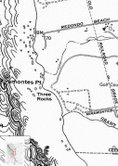
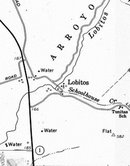
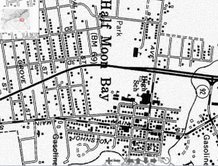
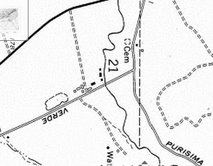
To see what tafoni looks like, please click here
“Learn about a fantastic rock weathering pattern,” according to website “owner” Jon Boxerman.
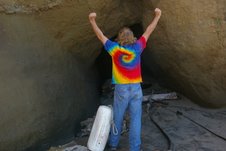 Says: John Vonderlin
Says: John Vonderlin
Hi June,
Here are a few tafoni pictures. I like the first picture because it’s a good example of the “classic” tafoni

grouping with an interesting setting of multi-colored layers of rock turned on their sides. The second and third are a long view and close-up of what I now believe is an example of “Ephemeral Beach Art.”


I think I sent this to you previously with the comment that I was not sure if it was manmade or natural. On further thought, I’ve decided that the chances of the rocks of almost perfect size and shape to be thrown into the hole just right to make it stay is small. While Nature, given time could accomplish most anything, it’s misses would surely have crushed the delicate tafoni structures in the meantime.
The fourth is a picture of mollusks occupying an apartment building-style, tafoni-riddled rock.

I hadn’t noticed these when I photographed it originally.
The lastis a “two-tone tafoni,” where the tafoni structure is of a different type and color of rock then the substrate below it.
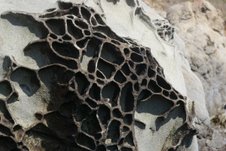
Enjoy. John
From: John Vonderlin
Email John ([email protected])
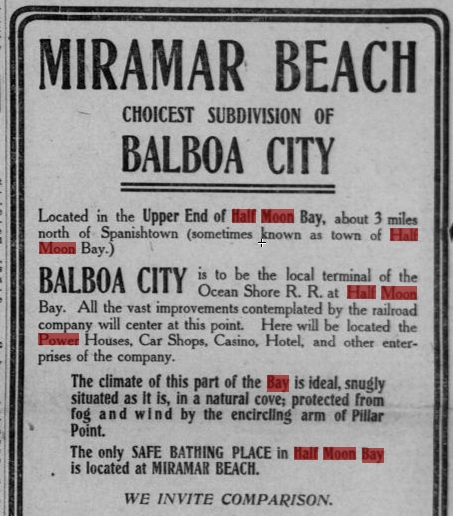
Hi June,
This ad from the January 3, 1906 issue of “The Call,” would seem to indicate that Shore Acres, the first subdivision in Balboa City, was sold out in 28 days. The ad announces the next two subdivisions of Miramar Terrace and Miramar Beach, were for sale at this time.
I believe the Great Quake killed Balboa City. I don’t think the power-house was ever completed, as the April 18th S.F. Quake put a serious hurt on the Ocean Shore Development plans. I’ll keep checking. Enjoy. John
Story from John Vonderlin
Email John ([email protected])
—————-
The following regarding “Balboa” is a partial message from Elaine M.Teixeira
“... do know the railroad company was trying to develop a city, one reason why so many lots were so small and substandard. Know my mother had to buy up extra lots down by the Lighthouse cafe in order to sell lots my dad bought at tax sales (unpaid taxes) as lots were 25 foot lots. I am pretty sure that our grocery store was always on Etheldore and Balboa… though it was called Sunshine Valley Road (Aunt Lil says her Dad gave the name to the road, so before might have been Balboa). On current computer maps, shows name of what I thought was officially Balboa, as Sunshine Valley Road.”
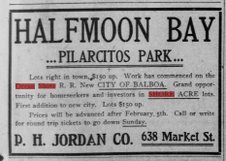
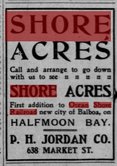
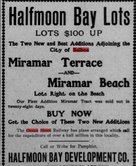
——–
Shore Acres was also a play, produced in the 1892s. Here’s John Vonderlin’s summary of “Shore Acres.”
SHORE ACRES
a play in three acts by James A. Herne
First performed in 1892
This analysis of Shore Acres was originally published in The British and American Drama of Today. Barrett H. Clark. New York: Henry Holt and Company, 1915. pp. 231-2.
This play was, according to all accounts, an intensely “human,” amusing, and, in places, exciting drama. The following quotations are illuminating; the first is from Montrose J. Moses’s The American Dramatist, the second from a letter by Henry George:
“Even in Shore Acres, during the scene in which Uncle Nat struggles with Martin in his effort to light the signal lamp, the sensational is very much in evidence; but the unerring art of Mr. Herne saved him from the accusation of intense, glaring melodrama. He understood thoroughly the balance between tension and quietude, and there is no bit of stage writing more natural, more cheerful, and more real than the act which succeeded this violent one in Shore Acres, Uncle Nat preparing the Christmas stockings. Those who are fortunate enough to recollect the wonderful naturalness of Mr. Herne’s acting will always point to the final curtain of this play, where Uncle Nat, left alone on the stage, by the very flexibility of his facial expression, depicted the full beauty of his character, as he closed up the room for the night, put out the lamps, and lighted only by the glow from the fire in the stove, slowly left the room as the cuckoo clock struck twelve.
————————–
Says John:
|
Hi June,
This ad in the ScreenShot I’ve attached seems to indicate Shore Acres was the first tract for sale in the new OSR “town.” of Balboa. This was from the Jan. 29th, 1906 issue of “The Call.” Bad timing with the Great Quake coming soon thereafter..
A very popular play of that name, “Shore Acres,”
 visited San Francisco in 1902. Perhaps, that’s what they were trying to evoke. I’ll keep looking. Enjoy. John
——–
HALFMOON BAY REAL ESTATE CALL and arrange to go with us to see Shore Acres, first addition to Ocean Shore R.R.; new city of Balboa on Halfmoon Bay: lots $150 up. P.H. JORDAN CO. 688 Market St. |
—————————-
Where was “Lipton-by-the-Sea” going to be located. Here’s the ad:

The Occidental Hotel started out to be 3 stories tall, then two stories tall, then gone….The stage driven by Half Moon Bay local Buckskin Bill Rawls stopped here daily on its way to Pescadero.

Story from John Vonderlin
Email John ([email protected])
John, I don’t know about an Olympic Club being contemplated for Half Moon Bay. There is the Olympic Club Golf Course (?) on Skyline Blvd in Daly City-Pacifica near the old horse ranch and the Pacific Ocean. Gorgeous spot.
The club, which also has a spectacular yacht club in the Marina, probably is well endowed, but certainly the financial crash hurt it like everyone else.
However, the El Granada Country Club was considered in the 1920s and 30s, and somewhere there may be sketches of the plans. I have some promotional material.
Perhaps the Olympic Club considered moving to the El Granada Highlands. I believe, at one time, some “heavy hitters” invested in land up there, with faraway views of Pillar Point Harbor. (I’m a flatlander myself.)
Which brings me to the other location of the Olympic Club, the beautiful white pillared business=looking arty building which I think has lovely amenities like a big pool. I love to swim.
Next door stands the ivy covered brick (?) Bohemian Club. I know them both, not because I was a member, but because I worked as a public information officer for the Society to Prevent Blindness, a nonprofit, and from time to time, the board of directors planned lunch at one or the other. Once or twice a year. Not bad, eh?
Good paintings on the walls. Old California art.
At the time the Bohemian allowed women in only one part of the building; that may have changed now. I don’t know. I didn’t care even then.I was hungry and I think you could actually tell whether you were getting chicken or fish. (Those of you who have had that weird experience: what is this? fish or chicken? Know what I mean)
(Sidelight: I also hate pumping my own gas. I still haven’t figured out how to hook up the thingy so I can stand back and watch. That means I hold the pump the whole time. Remember the nice young guys who used to do that for free? Long ago.)
The Board of Directors of my non-profit were old time San Franciscans, doctors and bankers and the like. One guy had the gold watch hanging out of his suit pants pocket. And his voice–from the 19th century.
At least one board member was a higher-up at Wells Fargo Bank in San Francisco. You may know they have had differences with the US government over taking or not taking the Tarp funds.
I just want you to know that the Wells Fargo men were very solid and old-fashioned. I’m talking about the older men. I was so surprised Wells Fargo was treated unfairly during congressional hearings –arguments over taking or not taking the money. Those guys from Wells were the straightest, most honest, upright men I have ever know. Long live Wells Fargo!
P.S. As I recall—-and please, please, correct me, Wells said they didn’t want the Tarp money because they had made NO BAD loans (re: real estate). They didn’t need TARP money; it was a burden to them.
I’m not ashamed to reveal that I’m not political (just a way to steal taxpayer’s money, these days, I think)—in fact at some point I will re- register as an independent, as if that matters. I have been a Democrat, a Republican and a Libertarian but none of these parties seem to reflect my beliefs. All of them have disappointed me.
Story from John Vonderlin
Email John ([email protected])